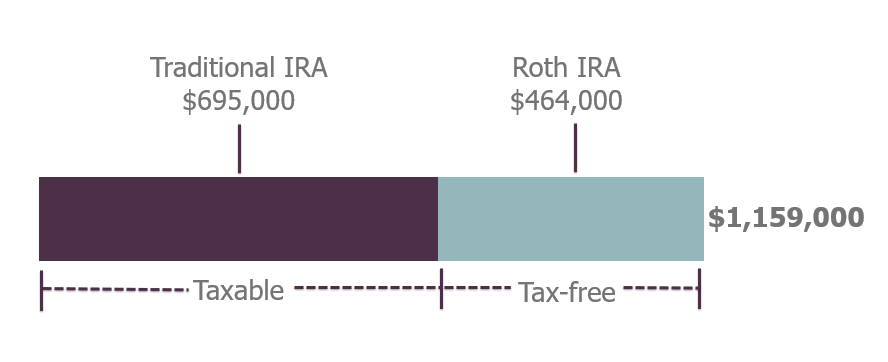Is There a Right Way to Make a Roth Conversion?
Converting some of your traditional IRA funds into a Roth can be a great strategy as you approach retirement. But be careful about how you incorporate such a move into your retirement withdrawal plan.


A commonly recommended strategy for reducing your tax burden and the impact of required minimum distributions (RMDs) is a Roth conversion. You’ll have no trouble finding information on why you should consider converting pretax IRA money to a Roth IRA in a low-income year. Simply put, a Roth IRA lets people at least age 59½ withdraw money tax free and is not subject to RMDs. But, what may be harder to find is a demonstration of how to fully maximize a Roth conversion’s potential benefits.
Keep in mind though, each person’s financial situation is different, meaning a Roth conversion doesn’t make sense for everyone. Since you must pay income taxes on the amount you convert to a Roth, it’s ideal to do it in a low-tax year. Some retirees who live off of a steady annual income throughout retirement may never have a low-tax year. So, a series of Roth conversions would only add to their taxable income and potentially push them into a higher tax bracket.
An example would be traditional IRA owners who have no income other than Social Security. As it’s unlikely Social Security is enough to cover all of one’s retirement expenses, it’s safe to assume you would need to supplement it with a regular withdrawals from your IRA each year. Thus, a Roth conversion would only increase your annual income and, subsequently, your tax burden.

Sign up for Kiplinger’s Free E-Newsletters
Profit and prosper with the best of expert advice on investing, taxes, retirement, personal finance and more - straight to your e-mail.
Profit and prosper with the best of expert advice - straight to your e-mail.
Nonetheless, there are many retirees who would be better off making a multiyear Roth conversion.
One couple’s story illustrates the Roth strategy
I find the best way to understand complex subjects such as this is through a story. Therefore, I would like to explore this strategy with a fictitious couple, but with actual dollar amounts. Everyone, meet John and Jane.
John and Jane are a retired, married couple who file their taxes jointly. They both turn 62 this November and will file for Social Security payments in January of next year. Together, they will receive $35,000 per year from Social Security. At the end of this year, they will have $750,000 in a traditional IRA and $250,000 in a trust.
John and Jane
Retirement date: Age 62
Combined Social Security benefit: $35,000/year
Assets:
- Traditional IRA: $750,000
- Trust: $250,000
Working with their financial adviser, John and Jane set a goal to keep the size of their retirement assets approximately the same as they approach age 90. They want to live a comfortable retirement but also leave some money to their children and grandchildren. They determine that given a 2.25% cost-of-living adjustment, they’ll have $70,000 in net income from savings and Social Security throughout their golden years. It’s also assumed that their accounts earn a pretax return of 5.9%. Now, let’s see how different strategies help them realize their goal.
Strategy 1: Drawing down assets proportionately
The first strategy they discuss is to take a proportionate withdrawal from both their IRA and trust money. Starting in January, they would take $28,000 in distributions from their IRA and $12,000 from their trust, which is about a 4% withdrawal rate. Adding in Social Security and subtracting taxes from their cash flow, they will have their annual target net income of $70,000. Throughout retirement, they will gradually increase both their trust and IRA withdrawals, keeping the IRA approximately three times the size of the trust.
At age 70½ though, they must start taking RMDs from their IRA. Because RMDs increase as you grow older, by age 85, their RMDs will be large enough that they can gradually cut back on trust distributions. Since they’ve withdrawn less than they earned, by age 90, they can expect to have $872,000 in their IRA and $258,000 in their trust, for a total of $1,130,000. The trust will still generate taxable income, and the IRA will still have unrealized taxes built in.
John and Jane’s assets by age 90

Strategy 2: Making a multiyear Roth conversion
The second strategy they consider involves a few different steps. From the time they retire at age 62 until age 70, they will live entirely off the trust account, preserving more money in their tax-sheltered IRA. In their first year, they withdraw $37,200 to pay expenses, including a tax bill of less than $1,000 that results from their Roth conversion. They will convert $15,000 per year for eight years from their IRA to a Roth. This keeps their taxable Social Security at or near $0. With the standard deduction, they will owe almost no income tax in their 60s.
Once they’re age 70, they should have approximately $1,030,000 in their IRA, $148,000 in a Roth and nothing left in the trust. When RMDs kick in, they will have to take the required amount plus a bit extra to still net them $70,000 per year, including income from Social Security. But, because they kept their IRA from growing too quickly in their 60s, through age 90, their RMDs remain smaller than what they need to take out to maintain their standard of living. The IRA will begin to shrink as they continue to take increasing distributions, but since the Roth account has been left alone, it will grow. By age 90, they have $1,159,000 in savings, 40% of which is in the Roth — tax free and with no RMDs in their lifetime.
Under this strategy, they end up with an extra $29,000 for retirement. But, the real victory is that $464,000 of their total savings is free and clear in a Roth account.
John and Jane’s assets by age 90

If John and Jane chose to convert their entire IRA to a Roth in their lifetime, they would need to double their annual conversions over those eight years to $30,000. Then continued distributions would eliminate their IRA by age 90, leaving $1,014,000 in the Roth. This is obviously a smaller portfolio than either of the previous scenarios, but the money is entirely tax free. This might benefit them depending on the income tax structure at that time or what’s best for their heirs.
As you consider your own strategy, be mindful that there are many balls to keep in the air. You have to understand the rules governing each account you own — qualified vs. non-qualified — as well as the taxability of your assets. Also, be wary of how your income will affect the amount of your taxable Social Security benefit. A Roth conversion can help keep more of your money working for you throughout retirement. But, this is a complicated calculation that may be best performed with the guidance of a financial adviser.
Profit and prosper with the best of Kiplinger's advice on investing, taxes, retirement, personal finance and much more. Delivered daily. Enter your email in the box and click Sign Me Up.

Sean McDonnell, CFP®, is a financial adviser at Advance Capital Management, an independent registered investment adviser based in Southfield, Mich. He works closely with clients to create and implement customized financial plans, as well as provides a wide range of services, including: investment and 401(k) management, retirement planning and tax strategies.
-
 Investing Abroad Could Pay Off — Here's How
Investing Abroad Could Pay Off — Here's HowCountries overseas are stimulating their economies, and their stocks are compelling bargains.
-
 Retire in Belize for Stunning Natural Beauty and Culture
Retire in Belize for Stunning Natural Beauty and CultureBelize offers miles of protected land and ocean, a rich mix of cultures and a chill lifestyle. Best yet — the income requirement is just $2K per month.
-
 Your Home + Your IRA = Your Long-Term Care Solution
Your Home + Your IRA = Your Long-Term Care SolutionIf you're worried that long-term care costs will drain your retirement savings, consider a personalized retirement plan that could solve your problem.
-
 I'm a Financial Planner: Retirees Should Never Do These Four Things in a Recession
I'm a Financial Planner: Retirees Should Never Do These Four Things in a RecessionRecessions are scary business, especially for retirees. They can scare even the most prepared folks into making bad moves — like these.
-
 A Retirement Planner's Advice for Taking the Guesswork Out of Income Planning
A Retirement Planner's Advice for Taking the Guesswork Out of Income PlanningOnce you've saved for retirement, you'll need your nest egg to support you for as many as 30 years. For that, you need a clear income strategy, not guesswork.
-
 Why Smart Retirees Are Ditching Traditional Financial Plans
Why Smart Retirees Are Ditching Traditional Financial PlansFinancial plans based purely on growth, like the 60/40 portfolio, are built for a different era. Today’s retirees need plans based on real-life risks and goals and that feature these four elements.
-
 To My Small Business: Well, I've Been Afraid of Changin', 'Cause I've Built My Life Around You
To My Small Business: Well, I've Been Afraid of Changin', 'Cause I've Built My Life Around YouWhile thinking about succession planning might feel like anticipating a landslide (here's to you, Fleetwood Mac), there are strategies you can implement to manage the uncertainty and the transition.
-
 These Are the Key Tariff Issues to Watch in Coming Months
These Are the Key Tariff Issues to Watch in Coming MonthsWhile they're not dominating headlines right now, tariffs are not over. Some key dates are coming up fast that could upend markets all over again.
-
 Technology Unleashes the Power of Year-Round Tax-Loss Harvesting
Technology Unleashes the Power of Year-Round Tax-Loss HarvestingTech advancements have made it possible to continuously monitor and rebalance portfolios, allowing for harvesting losses throughout the year rather than just once a year.
-
 The Fiduciary Firewall: An Expert's Five-Step Guide to Honest Financial Planning
The Fiduciary Firewall: An Expert's Five-Step Guide to Honest Financial PlanningArmed with education and awareness, you can avoid unethical people in the financial industry by seeking fee-only fiduciaries and sharing your knowledge with others.